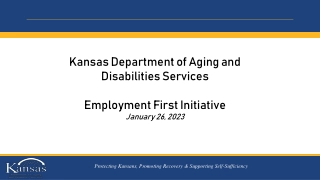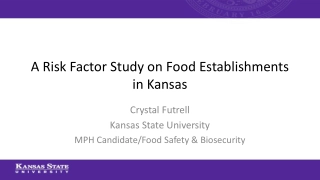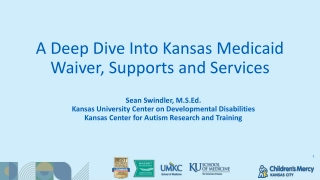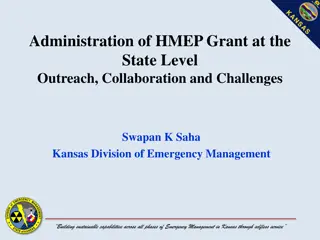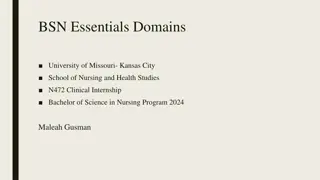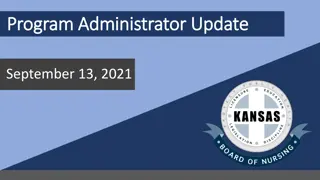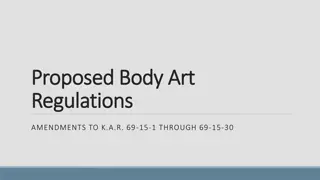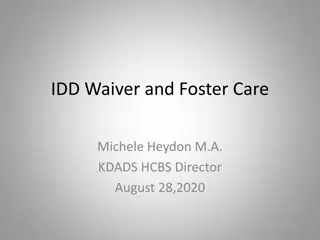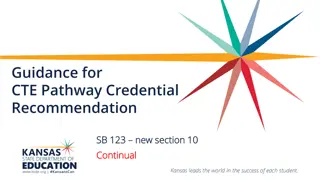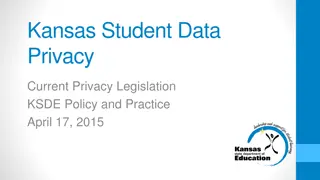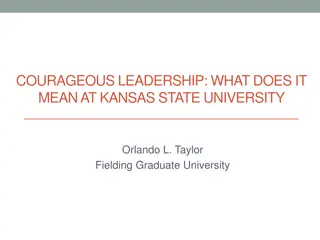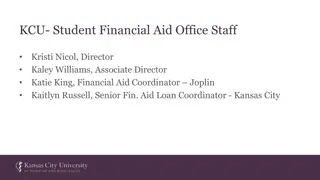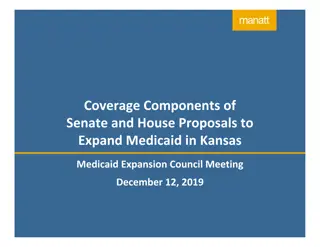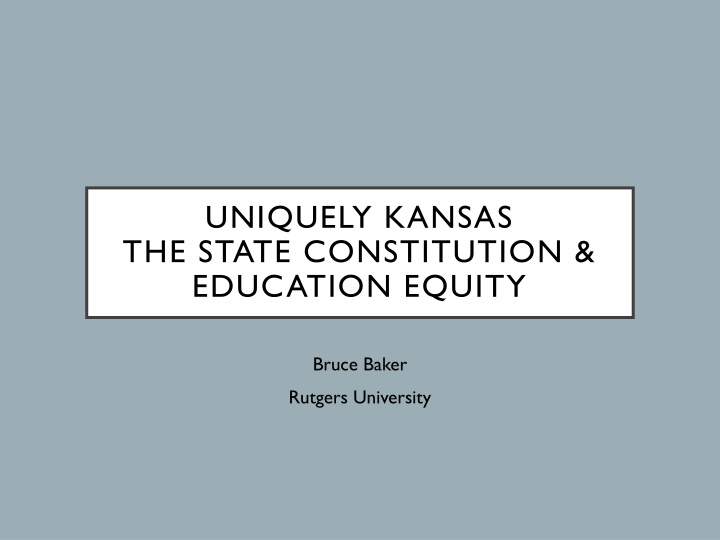
Uniquely Kansas: State Constitution and Education Equity Insights
Discover the unique conditions in Kansas, including the 1966 Education Article ratification, independent judicial selection process, and a dedicated legislature ensuring school finance reform. Explore the pivotal role of legislative research, legal counsel, and media coverage in shaping the state's education landscape.
Download Presentation

Please find below an Image/Link to download the presentation.
The content on the website is provided AS IS for your information and personal use only. It may not be sold, licensed, or shared on other websites without obtaining consent from the author. If you encounter any issues during the download, it is possible that the publisher has removed the file from their server.
You are allowed to download the files provided on this website for personal or commercial use, subject to the condition that they are used lawfully. All files are the property of their respective owners.
The content on the website is provided AS IS for your information and personal use only. It may not be sold, licensed, or shared on other websites without obtaining consent from the author.
E N D
Presentation Transcript
UNIQUELY KANSAS THE STATE CONSTITUTION & EDUCATION EQUITY Bruce Baker Rutgers University
8 CONDITIONS 1. The 1966 ratification of the Education Article of the Kansas Constitution, which established an independently elected Kansas State Board of Education, with self- executing constitutional powers to oversee elementary and secondary education (general supervision of schools) and required that the legislature shall make suitable provision for finance of the educational interests of the state. 2. A judicial selection and retention process, which reduces the role of political ideology among state high court justices, and limits turnover, providing the opportunity for state high court judges to develop a deep understanding, and institutional history of complex ongoing litigation. 3. A panel of high court judges with in-depth understanding of the complexities of school finance policy and the intersection with state constitutional requirements. 4. A legislature which that has been generally responsive to the state high court in terms of orders to increase and/or redistribute state aid, and in terms of meeting their its obligation to provide empirical evidence to guide school finance reforms.
8 CONDITIONS 5. An independent and trusted (bi-partisan) legislative research division (Division of Post Audit), which has played a role in performing and digesting empirical evidence pertaining to school finance reform, including collaborating with outside scholars. The availability (as a result of elements 4 & and 5) of high-quality evidence for (a) informing judicial evaluation of the state of school finance in Kansas and (b) for guiding legislative reforms. Tireless legal counsel with deep knowledge and institutional history, representing plaintiffs in several rounds and decades of litigation, from 1990 to the present day. The eighth element included throughout this book is the role of an informed media, covering the story from a variety of angles, providing historical context and background, and occasionally offering insightful, satirical perspectives on a topic that s really just not that funny. 6. 7. 8.
Drury, J. W., & Stottlemire, M. G. (2001). The Government of Kansas. University of Kansas, Division of Continuing Education.
1991-92 1966 Constitutional Revisions School District Equalization Act Mock vs. Kansas 1999 2006 Task Force (1999) A&M Cost Study (2002) Montoy v. Kansas Rulings 2003-2006 1992-94 School District Finance Act USD 229 v. State 2010 Present Brownback Tax Cuts (2013- 2017) Gannon v. Kansas Rulings 2013-2019 Chapter 1 Figure 1.1
SPENDING & OUTCOMES IN KANSAS & ITS NEIGHBORS NATIONAL EDUCATION COST MODEL Spending Above Target & Outcomes Above Average Spending Below Target & Outcomes Below Average Oklahoma 22.24 52.44 Colorado 47.72 29.03 Missouri 43.43 28.98 Kansas 58.12 13.24 Nebraska 65.89 0.58
Effort and Funding Gap $8,000 Spending Gap to Achieve National Avg. Outcomes $6,000 $4,000 Nebraska $2,000 Kansas $- Missouri $(2,000) Colorado $(4,000) Oklahoma $(6,000) $(8,000) 2.0% 2.5% 3.0% 3.5% 4.0% 4.5% 5.0% 5.5% 6.0% 6.5% Share of Personal Income
Salary Parity Ratio at Age 35 110% Teacher Wage as a Percent of Non-Teacher Wage 105% 100% 95% 90% 85% Nebraska 80% Kansas 75% Colorado Missouri 70% Oklahoma 65% 60% 2.0% 2.5% 3.0% 3.5% 4.0% 4.5% 5.0% 5.5% 6.0% Education Spending as a % of Personal Income
UNIQUELY KANSAS BALANCE OF POWERS State Supreme Court Apolitical appointment (& retention) since 1958 Stability over time (Deep knowledge of state) State Board of Ed Legislature Obligation ( shall ) for Suitable Funding for educational interests of the state Self-executing constitutional authority General supervision (outcomes & standards) As for the constitutional relationship between the legislature and the State Board of Education, this court has made clear that the general supervisory powers of the board under Article 6, Section 2(a) are " self-executing, " i.e., not requiring empowerment by the legislature. Gannon v. State, 319 P.3d 1196, 298 Kan. 1107 (2014)
UNIQUELY KANSAS BALANCE OF POWERS Gannon v. State, 319 P.3d 1196, 298 Kan. 1107 (2014)
CRITICAL TURNING POINTS May 11 2005 (following Jan ruling by KSSC) High court hearings over HB2247 Three-way split in oral arguments Biles (representing state board) posits that court must consider the state board s constitutional authority over outcome standards when evaluating legislative proposed cost study June 3, 2005 KSSC concurs Special session leads to LPA/D&Y Study Eventual passage of SB549 (and avoidance of constitutional amendment)
DJ VU ALL OVER AGAIN July 18 2017 High court hearings discuss KLRD successful schools analysis (especially tough questioning by Justice Biles) October 2 2017 Court notes logical flaws: Simply put, merely performing better than expected while perhaps a test for efficiency is not our Kansas test for constitutional adequacy. Leads to Taylor/WestED study
RELATIONSHIP AMONG COST STUDIES All All (Weighted) Large (Weighted) Duncombe & Yinger 2006 A&M 2002 Duncombe & Yinger 2006 A&M 2002 Duncombe & Yinger 2006 A&M 2002 A&M 2002 0.88 0.73 0.82 0.77 0.76 0.87 0.56 0.90 0.67 Taylor 2018 maintenance 0.65 0.63 0.81 0.48 0.86 0.62 Taylor 2018 scenario A 0.65 0.63 0.83 0.51 0.88 0.65 Taylor 2018 scenario B
WHATS TO GAIN FROM ALL OF THE LITIGATION & COST STUDIES? The modest goal To achieve a state school finance system that is less bad than it might otherwise have been in the absence of cost evidence and/or judicial pressure When does all of the litigation end? Maybe it doesn t and that s okay if the goal above is met The process is cyclical, requiring balance between the legislature and state board, which may require occasional mediation by the court
BEIERS JAN 2005 CONCURRENCE FUNDAMENTAL RIGHT I concur fully in the court's result and in the bulk of its rationale. I write separately only because I disagree with the holding of U.S.D. No. 229 v. State, 256 Kan. 232, 260- 63, 885 P.2d 1170 (1994), that education is not a fundamental right under the Kansas Constitution. I believe it is. I agree that the cases on which Justice Luckert and the Supreme Court relied remain persuasive on the wisdom of applying that standard to statutes providing for education finance in Kansas. However, I am not comfortable reasoning backward from that conclusion to say there is no fundamental right to education under our Kansas Constitution. In fact, on close reading, it is evident that Justice Luckert was also reluctant to make this backward leap of logic. It was not until the Kansas Supreme Court's opinion in U.S.D. No. 229 that Justice Luckert s use of a rational basis standard for review of school finance legislation was equated to a conclusion that the Kansas Constitution recognizes no fundamental right to education.
BEIERS JAN 2005 CONCURRENCE First, the language of the education article is mandatory. The legislature shall provide for intellectual, educational, vocational and scientific improvement and it shall make suitable provision for finance of the educational interests of the state. Kan. Const. Art. 6, 1, 6. Neither the provision of progressive educational improvement nor the financing of it is optional. Second, the education article s relationship to the constitution as a whole emphasizes its centrality to the document's overall design. Only five articles precede it. Each of the first three outlines one of the three branches of government. See Kan. Const. Arts. 1, 2, 3. The fourth and the fifth deal with elections and suffrage, without which the three branches could not be populated. See Kan. Const. Arts. 4, 5. Next comes education; once the branches are established and their seats filled, it appears education is the first thing on the agenda of the new state. See Kan. Const. Art. 6. The education article comes before those dealing with public institutions and welfare, the militia, county and township organization, apportionment of the legislature, and finance and taxation, among others. See Kan. Const. Arts. 7, 8, 9, 10, 11. Our constitution not only explicitly provides for education; it implicitly places education first among the many critical tasks of state government.
OTHER NOTES 1966 Article 6 amendments came about largely as an effort to create the power to oversee & enforce the school unification act Removal of uniform systems clause reduced equity pressures. Clause had been used during pre-Brown era to enforce equity between black and white schools. Bullock is (rightly to an extent) assigned much credit for his Mock pre-ruling But the real work was the negotiation between Finney (D) & Frahm (R) The lack of a formal ruling meant that one wouldn t occur until after reform legislation, setting a precedent that was then harder to overcome in Montoy

